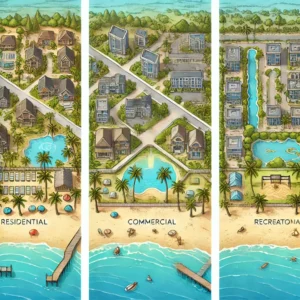Development zonings of private islands and beaches in the paradise islands of Anambas are one of the 3 following types. Moreover, each type follows specific regulations guiding which activities you can, and cannot, undertake.
1. Forestry (Hutan Produksi)
Forestry zones exist to manage and use forests responsibly. In fact, these zones focus on ensuring long-term ecological balance and maintaining biodiversity. Consequently, you may conduct sustainable logging, collect non-timber forest products, engage in eco-tourism activities like guided nature walks or bird watching, and pursue reforestation projects.
Allowed Activities:
- Sustainable logging
- Non-destructive harvesting of forest products
- Eco-tourism (e.g., guided nature walks, bird watching)
- Reforestation projects to enhance biodiversity
Prohibited Activities:
- Permanent conversion to non-forest uses like agriculture or permanent settlements
- Industrial-scale logging that ignores sustainable practices
2. Forestry for Conversion (Hutan Konversi)
Forestry for Conversion zones allow potential changes from forest to non-forest uses, typically agriculture or other development. However, you must follow specific regulations and conduct environmental impact assessments. Additionally, each conversion step should consider sustainability and ecological balance.
Allowed Activities:
- Conversion for planned agricultural activities under approved circumstances and proper permits (e.g., plantations such as palm oil, rubber, or other crops)
Prohibited Activities:
- Immediate, unrestricted conversion that ignores approved plans
- Uncontrolled land clearing
- Activities that damage the environment
3. Development (Kawasan Penggunaan Lain)
Development zones designate land for non-forest uses. Here, you may pursue industrial, residential, commercial, or infrastructure projects. Moreover, you must secure necessary regulations and permits to ensure environmental sustainability. In these areas, developers can consider urban and rural development, industrial projects, tourism infrastructure, agriculture, mining, and various commercial activities.
Allowed Activities:
- Urban and rural development
- Industrial projects
- Tourism infrastructure (resorts, hotels)
- Agriculture, mining, and other commercial activities (subject to zoning regulations and permits)
Prohibited Activities:
- Unauthorized or illegal development
- Activities that harm the environment without proper mitigation measures
- Violating zoning regulations
Other Important Factors to Consider
Development zonings of private islands and beaches can also be changed by purchasers. Keep in mind that land can undergo rezoning using a seven-step “APL” process. In fact, all zoning types support eco-tourism development under certain conditions. Additionally, the land certification process and title types vary based on zoning. Large pricing differences often exist between forestry, forestry for conversion, and development land areas.
Rezoning and Investment Opportunities
For sophisticated investors, significant differences in land values between zoning types, and the ability to rezone using the APL process, create lucrative opportunities. However, you should recognize that rezoning strategies involve expense and carry risk. Consequently, it is wise to seek guidance from subject matter experts before buying land intended for rezoning.
For more information, please check out Kepri Estates’ comprehensive Anambas Guide that can be downloaded for offline review at your convenience, or check out our informative YouTube channel, where you can review some of the amazing islands and beaches available for development. We are also happy to assist with any rezoning enquiries you may have, simply contact us directly at [email protected] for more information.
Check out the video below for a deep dive into private island investment due diligence.

